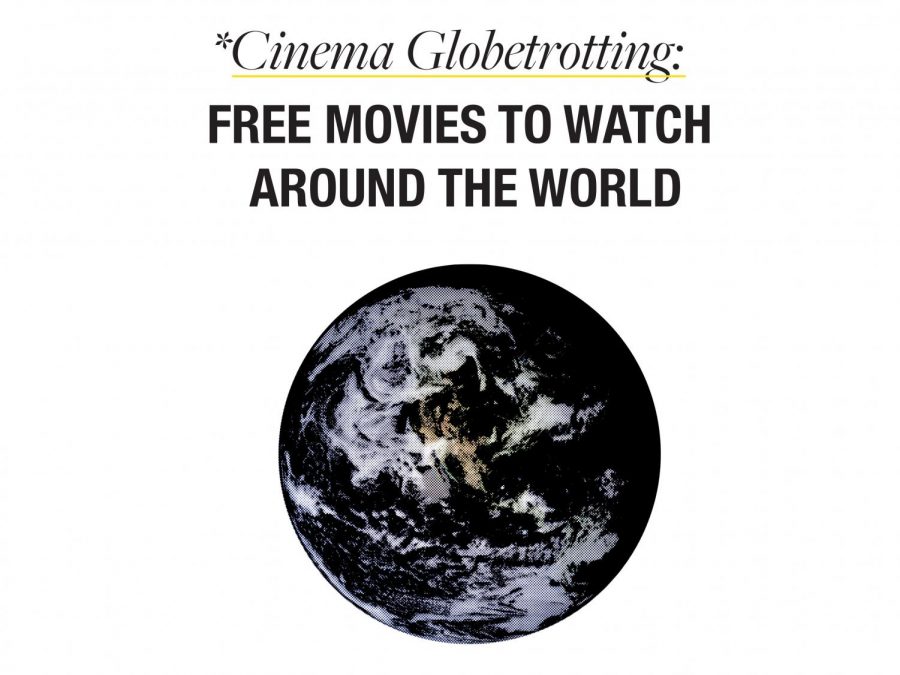Cinema Globetrotting: Free Movies to Watch From Around the World
January 16, 2020
Many compelling films hide amidst foreign language and independent titles which don’t make it straight away to commercial availability in the United States. Oftentimes, U.S. viewers only become aware of these movies when they break into an Academy Award nomination, make a major splash at big premieres or land funding with streaming services such as Netflix. Sadly, some deserving films either never make it so far, or if they do, continue to go unnoticed or don’t hold up in terms of popularity to incoming generations of viewers. On the flip side, it’s always a delight to discover a moving film one has never heard of before to find new stories and explore other cultures — qualities which attract fans to the world’s canon of independent and foreign language cinema in the first place. Pack your bags, grab that Nikon and don a straw hat. After researching which different streaming services University of Utah students may access for free, I’ve been able to come across a wonderful number of remarkable films from around the world this year I’d never would’ve before thought to seek out. Here are a few of my top favorite films from my own tour, all of which any U student can watch at no charge.
United States — “Killer of Sheep”
We begin our global cinematic trip in the USA. This particular drama, from one of this country’s greatest neorealistic directors of all time, Charles Burnett, is downright unmissable. Graced with the honors of being both one of the National Society of Film Critics’ 100 Essential Films and one of the top 50 movies selected for preservation by the Library of Congress, “Killer of Sheep” is now generally considered a landmark in black cinema. Due to copyright complications with its lively soundtrack which were not resolved until recently, the film was unfortunately only released to a few theaters around the nation upon its completion. Shot entirely handheld and without professional actors and sets, this movie evokes tender dignity in telling the story of an ordinary man who unwillingly works at a slaughterhouse to financially support his family in the poverty of Los Angeles. Its simplicity echoes something of a documentary but offers the narrative and layered structure of any successful fictional film.
Brazil — “Father’s Chair”
“A Busca,” or “The Search,” as it is titled in Portuguese, was nominated for the World Cinema category at the 2012 Sundance Film Festival and it also received a handful of nominations from the Cinema Brazil Grand Prize (one of the country’s most prestigious film award ceremonies). Despite this, it didn’t become find much success in the U.S. when it premiered here. The premise of this movie is that when a father places a looming divorce on hold as his teenage son goes missing, he sets out to find him. This storyline sounds simple enough to where one might think to condense it to the generic plot of “parent finds child,” which can be picked out from a variety of films ranging from “Taken” to “Finding Nemo.” However, the twist of this movie is utterly unique and the film’s exploration into this theme is original. If “Father’s Chair” doesn’t leave you meditating as to how you choose to love your own family members, the film is worth viewing for its amazing scenery of Sao Paulo.
Japan — “Rashomon”
Easily the most well-known film from my list of discoveries, “Rashomon” is frequently deemed one of the greatest Japanese films to have ever been created, particularly ever since it made an impactful appearance at the 1951 Venice Film Festival. From legendary director Akira Kurosawa, who was famous for his martial arts movies like “The Seven Samurai,” “Rashomon” gets weird, dreamlike and existential. After a woman accuses a thief of ambushing her, a medieval Japanese court must decide whether the thief is guilty by cross-examining as many witnesses as they are able to find. At the crux of the film’s themes, no two characters can agree on what had in fact happened, while each admits to their own wrongdoings at the same time. This movie feels as though it is composed of multiple short films each different in tone, though they all tie together to tease at a seeming truth beyond anyone’s reach. “Rashomon” is special in that it questions how we all choose to perceive truth in a sense that few other films like it have ever done or been able to replicate from this opus, Winner of Best Foreign Film at the 1952 Academy Awards.
Spain — “Cria Cuervos”
At the overturn of Francisco Franco’s dictatorship in the 1970s, young orphan Ana must learn how to grow up while under the care of her aunt. Lost in a world of broken families, memories and wishes, she must face with the death of her mother, her father’s betrayal to her family, and the tumultuous landscape of her home country. “Cria Cuervos,” winner of the Special Jury Prize Award at the 1976 Cannes Film Festival, illustrates a parable of reconciling individuality with choicelessness. According to director Carlos Saura, the film portrays childhood as a time when “you’ve no idea where it is you are going, only that people are taking you somewhere, leading you, pulling you and you are frightened.” This ultimately reflects the lives of those who lived under the political tumult of Spain’s leadership at the time. Of course, the world itself continues to grow more chaotic. How is it possible to reconcile our own desires when forces beyond our control shape our lives? “Cria Cuervos” reflects upon such questions with sharp brilliance.
Russia — “Chagall — Malevich”
If you wind up liking this film for no other reason than its visuals, “Chagall — Malevich” is worth the watch. It best reminds me of the 2016 movie “Loving Vincent” in that while its plotline is interesting, the film places most of its precedence on how it looks, and in that it tells a story about art history. This certain film explores the rivalry between painters Marc Chagall and Kazimir Malevich, and its color palettes will make anyone who enjoys movie aesthetic boards drool in delight. “Chagall — Malevich” was nominated for two best costume design awards in Russia’s Golden Eagle Awards and Nika Awards and it was also screened in the U. S. through the Atlanta Jewish Film Festival. Otherwise, it opened to mixed reviews. The movie is delightful — it’s just that it’s weird enough that it couldn’t appeal to a majority of moviegoers. Nonetheless, to those who love quirky, eccentric and highly visual films such as those made by Tim Burton or Wes Anderson, which are neither purely drama nor oddity, “Chagall — Malevich” is for you.
Lebanon — “Where Do We Go Now?”
This playful dramedy about the conflict and eventual friendship between two opposing congregations of Muslims and Christians in a small neighborhood feels especially resonant today as contemporary newsfeeds are rampant with debates about religious expression. We can all withstand to see more films that promote interfaith bonding, as writer and director Nadine Labaki aimed to achieve in this stellar movie. Besides, the number of awards that Labaki won in creating this film only points to its excellence, ranging from her earning the François Chalais Prize from the Cannes Film Festival to the People’s Choice Award from the Toronto Film Festival. Besides, “Where Do We Go Now?” features smart dialogue, believable acting from its cast and warm, uplifting humor woven throughout. Moreover, its message feels realistic in regards to the efforts that any person can make to strengthen a diverse community.
Poland — “Three Colors: Red”
One of Poland’s greatest directors, Krzysztof Kieślowski, is most well-known for his “Three Colors” or “Trois Couleurs” trilogy. Though not all audiences enjoy his lengthy, slow-paced and drawn out films, Kieślowski is a master of producing engrossingly sympathetic character studies. Shot not only in Poland but also in Switzerland and France, in part, “Red” is the final film of the trilogy. This film was nominated for several notable awards, including the Palme d’Or at the Cannes Film Festival and for best original screenplay at the Academy Awards. Don’t worry about skipping to the end — the series is a trilogy in its aesthetics rather than its storyline or characters. Even then, this film is certainly the most intriguing of the three. When a model befriends a local judge after she accidentally runs over his dog with her car, she becomes ensnared in a criminal court case which the judge solemnly swears to remain neutral towards. This judge, in turn, finds himself faced with questions about the nature of justice and righteousness he had thought himself to have already solved long ago. Ultimate he must determine not to allow his friend to make the mistakes he had.
Note: These films are available through streaming platforms and archives which U students and staff may access for free by logging in or registering with these services with a valid uID. In regards to these services, one can stream “Where Do We Go Now?” and “Killer of Sheep” from Alexander Street. From Digitalia, one can watch “Chagall — Malevich” and “Father’s Chair.” Lastly, through Kanopy, you can find “Rashomon,” “Cria Cuervos” and “Three Colors: Red.”
To those who are not affiliated with the U, these films are generally available to rent through other services, such as Vudu and Amazon.








